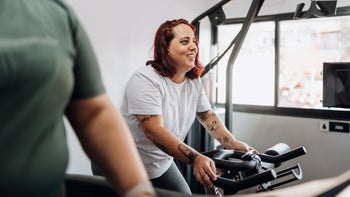
6 Strengthening Exercises for Achilles Tendonitis
Key takeaways:
Achilles tendonitis is a condition that occurs when the Achilles tendon is strained from overuse. It typically develops from too much or too intense physical activity.
If you have Achilles tendonitis, you should rest from aggravating activities like running and jumping. This will allow tendon irritation to calm down. Also try to limit time standing on your feet.
Strengthening exercises that target the calf muscles help Achilles tendonitis heal. They help reduce strain on the Achilles tendon to make walking and exercising more comfortable.
Table of contents

Achilles tendonitis is inflammation of the Achilles tendon. This important tendon connects the calf muscles to the heel bone. While Achilles tendonitis is very common in runners and other athletes, it can also affect people who are on their feet all day for work. It’s also more likely to happen if you have tight calf and hamstring muscles.
The majority of cases of Achilles tendonitis result from overuse. Athletes, for example, may get Achilles tendonitis after a sudden increase in exercise volume or intensity. Too much physical activity without enough rest causes inflammation, irritation, and breakdown of the tendon’s fibers.
Pain and tightness along the Achilles tendon can get worse with activity and limit your ability to walk, run, and exercise comfortably. Fortunately, most cases respond well to treatment with exercises. Learn more about six strengthening exercises for Achilles tendonitis, plus which activities to avoid while you heal.
Search and compare options
What are the best strengthening exercises for Achilles tendonitis?
The best exercises for Achilles tendonitis strengthen the two calf muscles — the gastrocnemius and soleus — that attach to the Achilles tendon. These muscles lift the heel up and push the foot off the ground with walking, running, and stair climbing. They also help with overall ankle stability and balance.
Working the calf muscles builds up strength and endurance. This allows them to better keep up with exercise and everyday activities, and support the Achilles tendon. This results in less strain.
Stretching exercises for the calf muscles are also important to decrease tension on the Achilles tendon. This can help prevent Achilles tendonitis from coming back or getting worse.
Exercises are effective for most tendon problems. Here’s what else you need to know about tendonitis.
Runners often experience Achilles tendon injuries. Learn why this and a handful of other injuries are common in runners.
Looking for Achilles stretches? We’ve got you covered with some of the best stretches for Achilles tendons.
1. Seated calf raises
The seated calf raise strengthens calf muscles as you contract them to lift your heels. Because this exercise is performed sitting down, it helps take tension off of your Achilles tendon from your body weight. This exercise is especially helpful in the beginning of recovery from Achilles tendonitis.
Step 1: Start in a seated position with your feet flat on the floor.
Step 2: Press through the balls of your feet to lift your heels up. Make sure your ankles stay in a neutral position. Don’t let your ankles roll outward.
Step 3: Hold for 5 seconds at the top, then slowly lower your heels back down to the floor.
Step 4: Repeat for three sets of 10 repetitions.
2. Toe walks
Toe walks improve the endurance of your calf muscles to stay contracted while standing. This helps to support your body weight with movement.
Step 1: Start in a standing position. You may want to hold onto a railing or counter for support.
Step 2: Contract your calf muscles to lift your heels up from the floor.
Step 3: Keep your heels lifted, and take several steps forward, walking on your tiptoes. Don’t let your heels drop down toward the ground.
Step 4: Walk at least 5 ft, then turn around and walk back.
Step 5: Complete 10 laps back and forth.
3. Single leg balance
The calf muscles and Achilles tendon assist the other ankle muscles to help you maintain your balance. Standing on one leg can strengthen all of these muscles and reduce irritation to your Achilles tendon.
Step 1: Start in a standing position. You may want to hold onto a railing or counter for support.
Step 2: Lift one leg and hold it up, trying to balance on one leg. Keep your hands hovered above the railing or counter to grab onto in case you lose your balance.
Step 3: Hold this position for 30 seconds, then relax.
Step 4: Repeat 3-5 times on each leg.
4. Heel raises
This exercise is similar to seated calf raises but is performed in a standing position. Heel raises are one of the best exercises to treat Achilles tendonitis. If they are too easy, you can make them harder by adding weight or standing on one leg.
Step 1: Start in a standing position with your feet together. You may want to hold onto a railing or counter for support.
Step 2: Press through the balls of your feet to lift your heels up. Make sure your ankles stay in a neutral position. Don’t let your ankles roll outward.
Step 3: Hold for 5 seconds at the top, then slowly lower your heels back down to the floor.
Step 4: Repeat for three sets of 10 repetitions.
Read more like this
Explore these related articles, suggested for readers like you.
5. Heel drops
Heel drops are a heel raise variation that’s performed off of an elevated surface. This modification focuses more on improving the eccentric strength of the calf muscles. Eccentric exercises involve slow, controlled relaxation of a muscle. This helps strengthen the tendon’s ability to tolerate load. You can progress to eccentric heel drops when you’ve mastered the first few exercises, which are a bit simpler.
Step 1: Start in a standing position with your feet together at the edge of a step. The balls of your feet should be at the edge of the step. Your feet should be hanging off of the edge. Hold onto the railings for support.
Step 2: Press through the balls of your feet to lift your heels up. Make sure your ankles stay in a neutral position. Don’t let your ankles roll outward.
Step 3: Hold for 5 seconds at the top, then slowly lower your heels down. Let your heels drop below the step. You should feel a stretch along the back of your ankles.
Step 4: Repeat for three sets of 10 repetitions.
6. Reverse lunge
A reverse lunge involves stepping backward and then pushing up from the ground. This exercise is a great lower-body strengthener that works multiple muscles together. It also targets the calf muscles to power the body up from a stretched position. Skip this exercise if you have knee problems.
Step 1: Start in a standing position with your feet together. You may want to hold onto a railing or counter for support.
Step 2: Step one leg directly back behind your body. Don’t cross your leg behind your other leg.
Step 3: Bend both knees and slowly sink your back knee down towards the ground. Your knee and ankle of your front leg should stay aligned with each other. Your hip and knee of your back leg should also stay aligned with each other.
Step 4: Hover your back knee right above the ground, or slightly tap your knee down on the floor. Do so slowly and with control. Don’t slam your knee down hard onto the ground.
Step 5: Slowly push through your back leg to return to a starting position. Bring your feet back together.
Step 6: Repeat for two sets of 10 repetitions on each side.
Dos and don’ts while rehabilitating from Achilles tendonitis
Most people fully recover from Achilles tendonitis with proper rehabilitation. You should avoid aggravating activities, but complete rest is not recommended. The Achilles tendon needs exercise and gradual loading over time in order to heal properly.
When rehabilitating from Achilles tendonitis:
Do:
Take a temporary break from aggravating activities like running and jumping.
Limit prolonged standing and walking.
Perform calf-strengthening exercises.
Go to physical therapy.
Try medication and applying ice to reduce pain.
Wear supportive footwear.
Don’t:
Push through pain with your exercises.
Rest from exercise completely.
Rush into high-impact exercise like running or jumping too soon.
Frequently asked questions
The fastest way to heal from Achilles tendonitis involves a combination of proper rest, targeted exercises, and gradual return to physical activity. Resting your tendon from movements and exercises that strain the tendon, like running and jumping, is especially important in the beginning stages of recovery from Achilles tendonitis. Once you build up strength with targeted exercises, you can gradually work your way back to more physical activity.
Walking is a great exercise that can be done almost anywhere. But sometimes, too much walking can irritate Achilles tendonitis. If you have Achilles tendonitis, avoid walking for prolonged distances in the beginning. Also avoid walking uphill or on uneven surfaces. Once your tendon irritation has calmed down and you start to build up more strength and flexibility, you can begin to walk short distances. Whenever walking, make sure you wear supportive footwear.
Yes. If you have a sore Achilles tendon, it’s important to incorporate stretching into your rehabilitation. Gentle stretching can help decrease tension on the Achilles tendon, which can reduce pain and irritation. Regular stretching also ensures that you have the proper range of motion needed for everyday activities. Just make sure not to overstretch your tendon, as this can cause more irritation.
The bottom line
Overuse and sudden changes in activity can cause Achilles tendonitis. Recovery starts with taking a temporary break from aggravating physical activity. Calf stretching and strengthening exercises are equally important. These will reduce strain and strengthen the Achilles tendon and surrounding muscles. Once your pain has calmed down and your calf muscles are stronger, you can gradually work your way back to more physical activity.
Why trust our experts?



References
ACE Fitness. (n.d.). Standing calf raises - wall. The American Council on Exercise.
Baptist Health. (2020). Gait toe walk [video]. YouTube.
California Mobility. (2018). Seated calf raises [video]. YouTube.
Carcia, C. R., et al. Achilles pain, stiffness, and muscle power deficits: Midportion Achilles tendinopathy revision 2018. Journal of Orthopaedic & Sports Physical Therapy.
Journal of Orthopaedic & Sports Physical Therapy. (2018). Optimizing recovery after Achilles tendon pain: Guidelines help deliver quality care.
Massachusetts General Hospital. (n.d.). Achilles tendinitis.
Mount Sinai. (n.d.). Heel pain and Achilles tendonitis - aftercare.
PureGym. (2018). How to reverse lunge. YouTube.
Shannon, K., et al. (2007). Standard of care: Achilles tendinopathy. Brigham and Women’s Hospital.
von Rickenbach, K. J., et al. Achilles tendinopathy: Evaluation, rehabilitation, and prevention. Current Sports Medicine Reports.
www.sportsinjuryclinic.net. (2011). Ankle exercise - eccentric heel drop. YouTube.





























